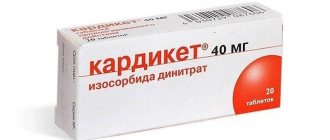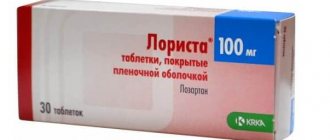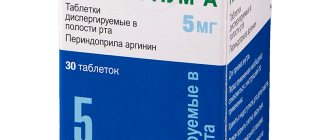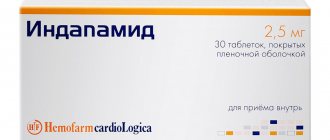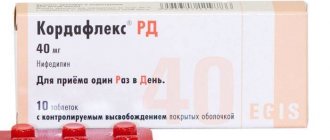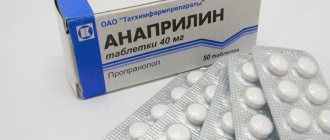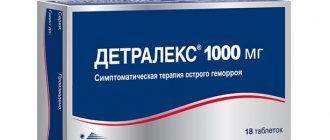Indapamide Retard compatibility
The manufacturer of high blood pressure tablets recommends avoiding the combination of the drug and lithium drugs.
This combination can cause an increase in the concentration of lithium ions in the blood plasma, a decrease in the excretion of these compounds by the kidneys, and therefore there is a possibility of a neurotoxic effect. Studies have shown that Indapamide Retard is combined with drugs that can provoke heart rhythm disturbances, but such combination therapy requires special attention to the patient. In case of certain deviations (the doctor will explain which ones in a particular case) the therapeutic course will have to be interrupted. There are risks associated with combining indapamide and:
- drugs for arrhythmia from category IA;
- third class of drugs against arrhythmia;
- phenothiazines;
- sotalol;
- benzamides;
- butyrophenones.
There is a risk of ventricular arrhythmia with a combination of indapamide and intravenous injections:
- erythromycin;
- Vincamine.
Certain dangers are associated with the simultaneous use of the blood pressure medication in question and pentamidine, moxifloxacin, astemizole, halofantrine, and bepridil.
It is necessary to warn the doctor about the ongoing drug therapy and all the medications the patient is taking. This will reduce the risk of negative interactions. The doctor will explain how the mutual influence of the drugs on each other can manifest itself, and will give instructions on how to behave in such a situation.
During the course, it is recommended to regularly check the patient’s condition, determine the concentration of electrolytes in the circulatory system, and take an ECG. If potassium deficiency is detected, drug therapy will have to be adjusted to avoid arrhythmia.
special instructions
The scenario of the health course is largely determined by the specific action of the reagents in specific conditions. And this must be remembered, because “Indapamide retard” (instructions for use, patient reviews and comments from authoritative doctors contain information about the nuances of the practical use of the medicine, but the ideal option is still an individual consultation) is directly related to the operation of vital systems and organs. For example, moderate functional liver disorders can be enhanced by a thiazide-like diuretic to such a degree that ultimately the therapy will result in full-fledged encephalopathy; similar negative manifestations are likely when taking pills during an exacerbation of renal failure.
Sometimes the long-term presence of a medication in a patient’s diet leads to the formation of stable photosensitivity (when in contact with ultraviolet radiation, the skin begins to behave inappropriately: ulcers, age spots, peripheral necrosis form) or provokes significant fluctuations in the ionic composition of the blood. It is impossible to predict the medical picture without the results of comprehensive examinations.
How to notice
The most significant manifestation of hypertension is blood pressure above 140/90. You can check the indicators yourself at home if you purchase a tonometer.
High blood pressure may be indicated by spots appearing before the eyes. Sometimes you feel dizzy and have a headache, and your vision is blurred. As a rule, the progress of the disease is associated with failures in the functionality of various internal organs. People suffering from high blood pressure are characterized by swelling, suffocation and shortness of breath are possible. Sometimes symptoms occur that suggest heart failure.
It is customary to distinguish three main degrees of hypertension. If the indicators vary within 159/99, they speak of the first degree. Progress is indicated by raising the parameters to 179/109. In the third degree, the pressure is above 180/110.
An isolated increase in systole only is possible when the first parameter exceeds 149, and diastole varies within 90.
There are several known reasons for this condition. If the disease is primary, in most cases it is not at all possible to determine why the pathology developed. It is known that the likelihood of experiencing high hypertension is higher if there are hypertensive patients among close relatives. Hypertension is more often observed in people over 50 years of age, as well as people who have bad habits, primarily smoking. Hypertension can be triggered by low mobility in everyday life, excess salt intake, endocrine diseases, diabetes mellitus, and frequent exposure to stress factors.
Secondary hypertension is often observed in diseases of the kidneys, blood vessels supplying these organs, and adrenal glands. There is a high probability of high blood pressure due to tumor processes and impaired blood dynamics. Lesions of the vascular system that cause hypertension are divided into congenital and acquired. Both types can equally cause higher than normal blood pressure. Another possible cause is obstructive sleep apnea. Sometimes hypertension is caused by taking medications (more often hormonal or temperature-lowering).
Nuances of use
Often, patients who have been prescribed the described drug are interested in the difference between Indapamide and Indapamide Retard, what is the difference between them. Both products are based on the same active ingredient, but the specificity of the composition is such that the drug with the prefix “Retard” in the name has a longer lasting effect. This product provides an effect on pressure within 24 hours due to the gradual release of the active component. This approach to creating the product made it possible to reduce the concentration of the main substance. This is another point that distinguishes Indapamide from Indapamide Retard. The first is produced with indapamide content in one capsule of 1.5-2.5 mg, the second is available only in one form - 1.5 mg.
It is up to the doctor to choose which option to use in a particular case. Doctors know better than ordinary people how Indapamide differs from Indapamide Retard, which means they can analyze which form to recommend to a particular patient. Choosing the optimal option is the key to effectiveness while minimizing the likelihood of side effects.
There is no universal answer to the question of which is better: - “Indapamide” or “Indapamide Retard”. Mostly, the instructions for use of these two medications are the same. They are based on the same active compound, there are no differences in indications or contraindications. The rules of use are no different. The doctor chooses for the patient which is better (“Indapamide” or “Indapamide Retard”). They take into account the financial aspect: usually Indapamide costs a little less than extended-release tablets. However, savings alone are not a sufficient reason to replace a drug prescribed by a doctor with another. The analogue “Indapamide Retard” (“Indapamide”) costs, although a little cheaper, but the difference is too insignificant to take it into account. If the doctor says that it makes no difference for the patient what exactly to take, then you can take any of the medications.
The active substance of the drug and its release form
The active ingredient of the drug "Indapamide-Retard" is indapamide. This substance belongs to the group of thiazide-like diuretics (diuretics). This means that the mechanism of action of this substance is to reduce the reabsorption of sodium and chlorine ions in the kidneys, as a result of which more fluid is removed from the body. In addition, indapamide has a vasorelaxant effect: it helps to expand the vascular lumen, reducing the sensitivity of the vascular walls. In addition, with long-term use of this drug, hypertrophy of the walls of the left ventricle of the heart decreases.
Enter your pressure
Move the sliders
120
on
80
This medicine has a prolonged action, which is ensured by its dosage. This means that this drug has a long-lasting hypertensive effect and lowers blood pressure for a long time. Produced in tablet form. The description is presented in table form:
| Criterion | Characteristic | |
| Compound | Indapamide | |
| Formative substances that ensure its safety and appearance | ||
| Concentration | 1.5 mg | |
| Packing | Package | Cardboard for 20 tablets |
| Quantity | 2 blisters of 10 pieces each | |
Main contraindications
The instructions position Indapamide Retard as an antihypertensive diuretic with vasodilating properties. Because of this, there are a number of restrictions regarding its use. So, in particular, contraindications for use are:
- intolerance to indapamide and/or excipients included in the pill;
- hypersensitivity to sulfonamide derivatives;
- severe form of renal failure;
- chronic or acute liver disorders;
- hypokalemia.
Considering the fact that the drug contains lactose, it is not recommended for patients in whom the absorption of this chemical compound is associated with any difficulties. When hyperarathyroidism is diagnosed and atypical urine acidity is detected, a diuretic is also not prescribed.
Due to the lack of reliable information regarding the reaction of a young body to the presence of indapamide, the medication is not used in the therapeutic treatment of minors (the category “under 18 years” is prohibited).
general information
According to the instructions, Indapamide Retard contains 1.5 mg of indapamide. In addition to the active compound, the drug contains additional components. The drug belongs to the group of long-acting medications. The active substance is located in the core of the capsule, the outer coating is a thin film shell made of a specialized substance. This makes taking pills simple and convenient.
The manufacturer used the following substances as auxiliary substances in the manufacture of Indapamide Retard tablets:
- hypromellose;
- lactose;
- povidone;
- silicon dioxide;
- magnesium stearate;
- opadray;
- titanium dioxide;
- talc.
Persons suffering from hypersensitivity or intolerance to any substances used in the pharmaceutical industry should carefully study the composition. In particular, the tablets in question are not suitable for people who are prohibited from lactose.
In the instructions for use of Indapamide Retard 1.5 mg (dosage of the active compound), the manufacturer indicates that the tablets are round, convex on both sides. The shell is white or close to white (grayish, brownish). The surface is slightly rough to the touch. If you cut a specimen, you can see two layers. Inside there is a white substance (a color close to white is possible), and the shell is white or has a slight shade of gray or brownish.
Important subtleties of reception
If the patient is prescribed cardiac glycosides, if the patient is undergoing a course of laxatives, taking Indapamide Retard requires checking the concentration of potassium ions in the blood and creatinine clearance indicators. Such measures are also necessary when taking a diuretic in elderly people and people suffering from hyperaldosteronism.
It is especially important to monitor the condition of patients taking diuretics to lower blood pressure if liver cirrhosis is detected. If the situation is complicated by ascites, swelling, there is a high probability of metabolic alkalosis
Liver encephalopathy in such conditions is much more pronounced, so the patient’s condition may worsen. Monitoring is also required when taking blood pressure medications by persons suffering from cardiac ischemia or heart failure.
Increased dangers are associated with the use of indapamide tablets by persons who have an abnormally long QT interval. This applies equally to those who have a congenital disorder and to cases of acquired disorders due to pathologies.
In diabetes mellitus, it is important to monitor the concentration of glucose in the circulatory system. Persons suffering from a lack of potassium in the blood should be especially attentive to their health.
Severe dehydration can cause acute kidney failure.
At the beginning of the course, it is important to constantly take tests to monitor kidney function. The doctor will explain how to replenish blood volume (BCV)
With gout, there is a risk of intensification and increased frequency of attacks of the disease.
During doping control, there is a possibility of receiving a positive response due to the use of indapamide.
The manufacturer indicates the need to be especially careful when driving if a person is taking Indapamide Retard tablets. This also applies to working with high-precision mechanisms and equipment. At the same time, there is no absolute ban on such activity.
Mother and child
According to reviews, Indapamide Retard (1.5 mg) is not used during pregnancy. Women who took these pills noted that when the fact of conception was detected, they had to refuse therapy at the insistence of the doctor. This is due to the risk of ischemia. While using the medication, there is a possibility of delayed development of the embryo.
During lactation, Indapamide Retard tablets are not recommended, since the active component can penetrate into milk. If it is not possible to avoid taking the drug at this time, the child should be switched to artificial nutrition.
Drug interactions
With the simultaneous use of GCS and tetracosactide for systemic use, the hypotensive effect is reduced due to the retention of water and sodium ions under the influence of GCS.
When used simultaneously with ACE inhibitors, the risk of developing hyponatremia increases.
When used simultaneously with NSAIDs (for systemic use), the hypotensive effect of indapamide may be reduced. With significant fluid loss, acute renal failure may develop (due to a sharp decrease in glomerular filtration).
When used simultaneously with calcium supplements, hypercalcemia may develop due to decreased excretion of calcium ions in the urine.
When used simultaneously with cardiac glycosides and corticosteroids, the risk of developing hypokalemia increases.
With the simultaneous use of drugs that can cause hypokalemia (amphotericin B, gluco- and mineralocorticoids, tetracosactide, laxatives that stimulate intestinal motility), the risk of developing hypokalemia increases.
When used simultaneously with tricyclic antidepressants (including imipramine), the hypotensive effect is enhanced and the risk of developing orthostatic hypotension increases (additive effect).
When used simultaneously with astemizole, bepridil, erythromycin (iv), pentamidine, sultopride, terfenadine, vincamine, quinidine, disopyramide, amiodarone, bretylium tosylate, sotalol, there is a risk of developing ar.
When used simultaneously with baclofen, the hypotensive effect is enhanced.
When used simultaneously with halofantrine, the likelihood of cardiac arrhythmias (including ventricular arrhythmias) increases.
When used simultaneously with lithium carbonate, the risk of developing the toxic effect of lithium increases due to a decrease in its renal clearance.
With simultaneous use with metformin, the appearance of lactic acidosis is possible, which is apparently associated with the development of functional renal failure caused by the action of diuretics (mainly “loop”).
When used simultaneously with cyclosporine, an increase in the creatinine content in the blood plasma is possible, which is observed even with normal levels of water and sodium ions.
Indapa's analogs
Medicines containing indapamide as the main active ingredient are considered analogues of Indap.
Analogs of Indap of Russian and foreign production:
| Russian analogues | Price, rub, 30 capsules | Foreign analogues, country of origin | Price, rub |
| Acripamide | 41 | Indap, Czech Republic | 113 |
| Acripamide Retard | 81 | Arifon, France | 307 |
| Vero-Indapamide | 40 | Indapamide, Serbia | 91 |
| Indapamide Mv Stada | 110 | Ravel SR, Slovenia | 164 |
| Indapamide Retard | 91 | Lorvas SR, India | 62 |
| Arifon Retard | 366 | Indapamid-Teva, Israel | 88 |
| Indapamide MV | 90 | Arifon Retard, France | 347 |
| Ionic | 105 | Indipam, Bulgaria | 115 |
| Tenzar | 199 | Arindap, Poland | 119 |
Let's take a closer look at the best way to replace Indap. Of the foreign medicines, Lorvas SR and Indapamid-Teva are considered the cheapest.
They have a positive effect on blood pressure levels. They increase the elasticity of the walls of blood vessels and increase their diameter. They are diuretics. The principle of operation of these media is absolutely identical to Indap.
Lorvas SR 1.5 mg
Ravel SR is an analogue of Indap, which is similar in properties to thiazide diuretics. Indicated for hypertension. Can be used more often than Indap and in larger doses.
Higher doses have no effect on blood pressure, but diuresis increases. There is a risk of the following side effects: arrhythmia, asthenia, itching, nausea, vasculitis, migraine, urticaria, sinusitis.
Russian and foreign Arifon Retard are the most expensive compared to other Indapa generics.
Their action is identical to Indapamide. The effect of Arifon is reduced by adrenergic stimulants when taken simultaneously, and is enhanced by antidepressants.
Approved with caution for the treatment of hypertension in diabetics and patients with liver cirrhosis. Not recommended for therapy for lactating and pregnant women, children under 18 years of age, with anuria, encephalopathy
Most often, patients respond positively to the medication.
It is reported that blood pressure remains normal for a long time, and adverse reactions occur rarely.
Based on reviews from doctors and patients, a rating of Indap substitutes can be made.
The most effective analogues are Indapamide, Lorvas SR, Ravel SR, Arifon Retard.
They come in different price groups, but are widely used. The effect of medications is individual.
Choosing Indap analogues and drug replacement based on the cost of drugs is not always correct
It is worth paying attention to your well-being, side effects, and concomitant diseases.
List of analogues of Indapamide Retard
If it is necessary to replace the drug, there are two options - choosing another medication with the same active substance or a drug with a similar effect, but a different active substance.
Analogues of Indapamide Retard, list of drugs:
- Acripamide,
- Arifon,
- Vero-Indapamide,
- Indap,
- Indapamide,
- Ionic,
- Indapres,
- Indapsa,
- Ipres long.
When choosing a replacement, it is important to understand that the price, instructions for use and reviews of Indapamide Retard do not apply to analogues. Before replacing, you must obtain the approval of your doctor and do not replace the drug yourself.
Most reviews of Indapamide Retard indicate the high effectiveness of the drug. Hypertensive patients generally tolerate the medication well. Reviews from doctors and patients, as well as forums where issues of treating hypertension are discussed, convincingly confirm this fact.
Side effects are rare and characterized by mild severity. Many hypertensive patients take pills for life.
…
Clinical trial results
It has been reliably established that the described antihypertensive drug in its biochemical properties is very close to the behavior model of thiazide diuretics, that is, when it enters the body, it stimulates inhibition of reverse absorption with the participation of sodium ions (we are talking about the cortical segment of the so-called nephron loop). Long-term observations of the progress of monotherapy based on this medication (with a dosage that excludes a targeted increase in urination) made it possible to identify regular demonstrations of the desired result over time periods of 24 hours. In other words, even with a decrease in the recommended daily intake, indapamide has a targeted effect on vascular smooth muscle, which leads to suppression of characteristic symptoms and normalization of blood pressure. When the optimal dose was exceeded, almost all patients experienced a sharp development of side dynamics against the background of stabilization of the already obtained positive indicators.
Pharmacological kinetics
In terms of absorption, Indapamide Retard (reviews from specialized experts testify to this) is a very remarkable diuretic: the bioavailability of its components exceeds 93%, while the main reagent, which is placed in the original matrix carrier, is not released immediately. Since there is controlled absorption of the active ingredient in the gastrointestinal tract, when using the drug it is possible to achieve a healing effect without resorting to drug overload of the liver and kidneys.
The instructions emphasize that simultaneous administration of the medicine with food can slow down the absorption process of indapamide by 5-20 minutes, but the meal does not affect the proportion of the absorbed substance. The maximum concentration of components in the blood is expected 11-12 hours after a single use (the rate of biological processing of the pill depends on the individual characteristics of the body)
Indapamide is bound by plasma protein compounds (at a level of 79% of the total volume absorbed), but does not accumulate in cells: after 2/3 days, 50% of the reagent is transformed into inactive metabolites and excreted in urine and feces.
Manifestation of adverse reactions and symptoms in case of overdose
Side effects include:
- the concentration of potassium in the blood is greatly reduced, resulting in dehydration;
- feeling of dry mouth;
- the patient is very nauseous;
- severe headaches;
- allergic manifestations;
- heart rhythm disorders - both higher and lower;
- urinary tract infections, large amounts of urine excreted at night;
- excessive stress, sleep problems, weakness, anxiety;
- the appearance of sugar and nitrogen in the blood, a decrease in the level of platelets and leukocytes in the blood.
An overdose can manifest itself as a feeling of weakness, nausea and vomiting, gastrointestinal dysfunction, and water-electrolyte imbalance. Sometimes blood pressure drops sharply. To eliminate an overdose, gastric lavage is performed and therapy is carried out depending on the existing symptoms.
Mode of application
Indap is taken orally. The optimal time of administration is considered to be early morning. The capsule must be swallowed without chewing, washed down with still water. Eating does not affect the effect of the medication.
The standard dose of indapamide per day does not exceed 2.5 mg. You need to take the medication once a day.
Indap is used for monotherapy, in combination with MKK blockers, ACE inhibitors.
Increasing the dose is considered inappropriate. If there is no therapeutic effect, it is better to prescribe another drug with an antihypertensive effect.
Increasing the dose does not improve the patient's condition, and the risk of side effects increases.
Instructions for use
The medicine "Indapamide retard" is a long-acting medicine that must be taken once a day. The dosage of the active substance depends on the severity of the disease and is adjusted by the attending physician. It is most effective to take the product in the morning, on an empty stomach. Take the tablet or capsule with plenty of water. If necessary, after 28 days the dose can be adjusted. If this does not provide the desired therapeutic effect, it is recommended to take an additional drug for high blood pressure, which does not have a diuretic effect. The duration of the course of treatment for blood pressure medication is determined only by the doctor.
The minimum period of taking the drug is 90 days. Improvement occurs immediately after consuming the tablet or capsule and lasts up to 24 hours. Normalization of blood pressure occurs within 10 days after starting to use the medicine.
Contraindications
The instructions for use of the drug prohibit the use of the drug if the patient is under 18 years of age and if the patient has such factors in the anamnesis as:
Pregnant women should not take the drug.
- allergy to the components of the medication;
- pregnancy and breastfeeding;
- cerebrovascular accident;
- diabetes;
- kidney and liver diseases;
- gout;
- hypotension;
- water-electrolyte imbalance;
- some heart ailments.
Side effects
Uncontrolled use of a medication for hypertension, its use without a doctor’s permission, exceeding the permissible dose and course of administration, as well as if the patient has a tendency to allergies can cause side effects such as:
- dizziness and headache;
- increased fatigue;
- anemia;
- a sharp decrease in pressure;
- arrhythmia;
- nausea and vomiting;
- rash;
- itching;
- swelling of the limbs;
- joint pain;
- dry mouth;
- exacerbation of gastrointestinal diseases;
- hyperkalemia;
- drowsiness;
- depressed state;
- dyspnea;
- anuria or polyuria;
- conjunctivitis;
- rhinitis;
- increased sweating;
- cough;
- deterioration of visual acuity;
Compatibility with other drugs
It is not recommended to take the drug and acetylsalicylic acid at the same time.
The manufacturer of the medicine for high blood pressure does not recommend using the medicine simultaneously with diuretics, glucocorticoids, and laxatives, as this can cause hypokalemia. The simultaneous use of Indapamine retard with drugs such as: can cause severe arrhythmia and even lead to death:
- tricyclic antidepressants;
- neuroleptics;
- ACE inhibitors;
- acetylsalicylic acid;
- quinine;
- disopyramide;
- aiodarone;
- Brethelia tositate;
- dofetilide.
Composition and release form
We will talk about contraindications and side effects of Indapamide below. In the meantime, let’s figure out what’s in the medication.
It comes in several forms:
- Capsules, which are packaged in blister packs of 5, 6, 7, 10, 30 pcs. or in jars of 10, 20, 30, 40, 50, 100 pcs.
- Long-acting coated tablets - in blisters of 10 pcs. or 30 pcs. in banks.
- Modified-release coated tablets – in blister packs of 10 and 14 pcs.
This medicine contains an active element – indapamide. Auxiliary components of the capsules are: magnesium stearate, microcrystalline cellulose. Additional substances in the tablets: hypromellose, lactose monohydrate, magnesium stearate, colloidal anhydrous silicon dioxide, polyethylene glycol, croscarmellose sodium, crospovidone, povidone K30, talc, sodium lauryl sulfate
It is important to find out the contraindications of Indapamide in advance.
Description of the drug
Indapamide Retard is considered a popular diuretic drug with a pronounced antihypertensive effect, which is used for arterial hypertension.
The drug is produced by several companies:
- Servier is a French company.
- MED.CS is a Czech company.
- Nizhpharm is a Russian manufacturer.
- ALSI Pharma is a Russian company.
- Kanonpharma Production - Russian production.
Trade name: Indapamide Retard. INN - Indapamide is a diuretic, vasodilating antihypertensive agent.
Release forms and average prices
The medicine is produced only in tablet form. These are long-acting tablets, white, round, biconvex, film-coated. Available in:
- blisters of 10, 15, 20, 30 pcs.;
- containers of 10, 20, 30, 40, 50, 100 pcs.
You can purchase the medication at the prices presented in the table (Table 1).
Table 1 - Cost of the drug
| Retard, manufacturer, mg, pcs. | Price, rubles |
| Ozon LLC, Russia 1.5№30 | 34,00 |
| Alsi Pharma, Russia, 1.5 No. 30 | 36,00 |
| Kanonpharma Production, Russia, 1.5№30 | 76,00 |
| Hemofarm, Serbia, 1.5№30 | 95,00 |
Compound
One tablet contains the active ingredient – 1.5 mg. Excipients include:
- osmotic diuretic mannitol;
- hypromellose;
- povidone;
- magnesium salt of stearic acid;
- silica.
Shell includes:
- thermoplastic polymer PVA;
- titanium oxide;
- polyethylene glycol;
- talc.
Pharmacodynamics and pharmacokinetics
Retard has been present on the market of pharmacological drugs for quite some time. Its popularity is explained by:
- high efficiency, which is noticeable after just a week of regular use;
- rare side effects;
- a small number of contraindications (this drug is prescribed even for diabetes);
- availability and low cost.
Pharmacological properties
The medicine affects the body in several directions:
- reduces blood pressure;
- has a moderate diuretic effect;
- expands the vascular lumens to increase their patency.
It is a thiazide-like diuretic, a vasodilator with a pronounced vasodilator effect. Even a small dosage (up to 2.5 mg) can reduce the vascular response to the effects of vasoconstrictor elements, as a result of which blood pressure decreases.
In addition, the drug strengthens vascular walls and protects the myocardium in hypertensive patients. In increased dosages (up to 5 mg), the substance fights swelling even more effectively, but at the same time, as the volume of the active component increases, there is no more noticeable effect on blood pressure levels compared to the minimum dosage.
Taking tablets simultaneously with food delays the absorption of the active ingredients, but does not affect the effectiveness of the drug. Therefore, to speed up the action of indapamide, experts recommend taking the medicine on an empty stomach, but it can also be taken after a main meal.
The capsule form of the drug ensures long-term uniform release and rapid absorption of indapamide in the gastrointestinal tract. The maximum concentration of the active substance in the blood is achieved within 12 hours. With repeated doses of the drug, fluctuations in the concentration of the substance in the blood plasma in the interval between taking subsequent doses decrease.
The main metabolism occurs in the liver, metabolites are excreted mainly by the kidneys. Therefore, the use of the medication may negatively affect the health of people with liver or kidney problems. The half-life is up to 24 hours.
Indap
The medicine is produced by the Czech company PRO.MED. CS. The medicine is a synonym (analog) of Indapamide. The diuretic gently lowers blood pressure. The effect of use appears after 9-11 days.
Main characteristics:
- appearance: white capsules with a bluish cap, contents – powder;
- dosage: 2.5 mg indapamide per capsule;
- group: the medicine is intended to reduce blood pressure in hypertension;
- subgroup: diuretic;
- composition: active ingredient (indapamide hemihydrate), additional ingredients - silicon dioxide, cellulose, starch, gelatin elements;
- reception: once a day;
- price: average cost ranges from 85 to 125 rubles.
The action of Indap is to reduce peripheral vascular resistance, reduce the tone of blood vessels and arteries. It has a moderate diuretic effect, blocking chlorine, hydrogen and sodium ions.
Contraindications: gout, hypokalemia, severe pathologies of the kidneys and (or) liver, patient age under 18 years, allergy to components. Capsules are not recommended for pregnant women. The lactation period also serves as a contraindication to the use of the medication.
Special recommendations: Indap is usually well tolerated by patients. Effective in the treatment of people with diabetes (except in the last stages)
Since the drug is excreted primarily by the kidneys, people with dysfunction of these organs are recommended to take the medication with great caution. Liver disease poses a risk of metabolic alkalosis or encephalopathy
Symptoms of overdose and initial management of consequences
Signs of acute poisoning include:
- extreme reduction in blood pressure;
- permanent dizziness;
- loss/cloudness of consciousness;
- spasms of the upper and lower extremities;
- oliguria.
However, all of the above symptoms are, rather, a consequence of an imbalance in the water-electrolyte balance of the body, rather than the result of biochemical aggression of the active ingredients, because in the course of full-scale laboratory studies, no signs were found that the drug “Indapamide retard” is capable of having a direct toxic effect on the human body . At least 27 times the daily norm does not cause noticeable disturbances in the functioning of organs and systems.
Symptomatic treatment of overdose is reduced to stimulating the removal of reagents in a natural way (use of activated carbon; if necessary, gastric lavage).
What are the composition and properties?
The drug "Indapamide retard" contains from 1.5 to 25 mg of indapamide, depending on the type of medicine. This main active ingredient of the drug is a diuretic and vasodilator, that is, it removes excess fluid naturally, increasing the removal of calcium, magnesium and sodium ions from the body, and at the same time increasing the lumen in the blood vessels. This improves blood flow and thus the pressure returns to normal. The component can also improve the elasticity of arterial walls and reduce the amount of the hormone angiotensin secreted, which is usually elevated in hypertensive patients. The medicine is available in the form of tablets or capsules. In addition to the main ingredient, the drug contains the following components:
- lactose;
- povidone;
- hypromellose;
- colloidal silicon dioxide;
- mannitol;
- triacetin;
- magnesium stearate;
- titanium dioxide;
- macrogoal
pharmachologic effect
The diuretic, antihypertensive drug Indap lowers blood pressure by reducing the tone of the smooth muscles of blood vessels, arteries, and peripheral vascular resistance. The effect of taking the medication appears 7-10 days after the start of treatment.
A medication containing indapamide is prescribed to hypertensive patients for the treatment and prevention of pressure surges when edema occurs.
In patients with the following diseases, Indapa is contraindicated:
- anuria, renal failure;
- hypokalemia;
- cerebral circulatory disorders;
- pregnancy;
- lactation;
- lactose intolerance;
- galactosemia;
- hypersensitivity to the constituent components.
When diagnosing the following diseases in patients taking Indap, strict medical monitoring of their health status is necessary:
- hyperparathyroidism;
- decompensated diabetes mellitus;
- IHD;
- ascites;
- hyperuricemia;
- hyponatremia.
Elderly people should monitor potassium and creatine levels when prescribing Indap.
Children under 18 years of age are considered a contraindication for taking the medication.
